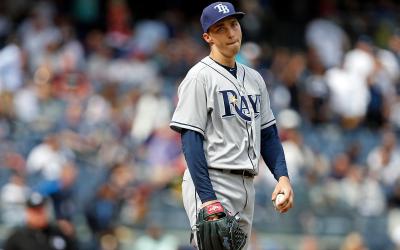In this week’s edition of Sabermetric Tuesdays we’re going to take a look at one of my favorite indicators for Pitchers: the Runners Stranded Percentage. The Runners Stranded Percentage is a pretty simple statistics to understand, it’s simply measuring the amount of base-runners a pitcher is able to strand on the basepaths. The average Runners Stranded Percentage for a pitcher is typically between .72 and .75, meaning a typical pitcher will allow approximately ¼ of the base-runners they allow on base to cross home plate. For the most part, pitchers do not have much control over their Runners Stranded Percentage from year to year, with the main exception being pitchers who have a high K Rate. Conceptually this makes some sense. Pitchers who are able to strike more batters out are able to keep the ball from going in play and thus prevent base-runners from scoring on a number of different ways like RBI ground outs or Sac Flies, etc. The chart below further illustrates this point (listed below are the 3 year averages in K/I data and Runners Stranded Percentages for all pitchers):
As you can see while there is a pretty strong relationship between the K Rate and the Runners Stranded Percentage the actual differences in Runners Stranded Percentages are rather modest, with the vast majority of the groups falling between a .69 Runners Stranded Percentage and a .75 Runners Stranded Percentage. While analyzing K Rates in comparison to Runners Stranded Percentages is important, the more important connection is the relationship between ERA and Runners Stranded Percentages. As you can probably guess from the definition of Runners Stranded Percentage, Runners Stranded Percentage and ERA have an intimate connection. The two statistics have an inverse correlation, as Runners Stranded Percentages go up, pitchers ERA’s tend to go down more than they should. Conversely as Runners Stranded Percentage goes down, pitchers ERA’s tend to go up more than they should.
Thus by identifying large discrepancies (in either direction) in pitchers’ Runners Stranded Percentage in any given year vs. their career averages, we can identify pitcher’s who we anticipate to have a large future change in ERA. The one caveat comes with what we discussed earlier, the K Rate. If a player’s K Rate and Runners Stranded Percentage have moved in the same direction from their career norms, it’s less likely a correction will occur. With that in mind, let’s take a look at some of this year’s data and compared to player’s 3 year-average data (from 2005-2007) and see if we can identify some candidates for regression in both a positive and a negative way. For fantasy purposes we’ll focus on SP’s.
First let’s take a look at Pitcher’s with unsustainably high Runners Stranded Percentages. For these pitchers improvements made in their K Rates are negated by the unsustainable level of their current Runners Stranded Percentages and they’re likely to see increases in their ERA as the season progresses.
Data Through 6/6/2008
Players highlighted in Yellow are those with increases in their Runners Stranded Percentages but decreases in their K Rates. This is an automatic signal that a correction in their ERA is going to come at some point. A number of top tier starters lead this list, which you’d expect as these are the pitchers that have had the most “luck” early in the season and the saying goes you often create good luck with good skill. Regardless all of these SP’s are going to see some sort of regression in their ERA as the season progresses. The ones to be the most concerned about are those with the negative K/I Deltas and the largest Strand Deltas. John Lackey is on a whole other level, but that’s largely skewed because of the smaller sample size, Lackey’s 1.70 ERA clearly isn’t sustainable but you didn’t need me to tell you that. The next group in line for some significant regression in their ERA include: Daisuke Matsuzaka, Ben Sheets, Joe Saunders, and Carlos Zambrano. As a side-note I always find it funny how this stuff works out. Big Z had his worst outing of the year on Saturday (which these numbers do no include) and as I’m typing Joe Saunders is getting raked around the yard by the Rays. There might be something to this…
The other pitchers highlighted in Yellow, should have a regression in their ERA as well although it shouldn’t be as significant as the others because their K Rates and Runners Stranded Percentages have had more muted levels of Delta. The un-highlighted group has made improvements in their K Rates which should result in modest increases in their Runners Stranded Percentages, but certainly not to the current extent that their Runners Stranded Percentages sit at and they’re likely due for regression as well. Josh Banks and Jorge Campillo in particular are due for some pain ahead as their K Rates aren’t elite enough to get them into the mid-70’s and they’re currently above .85. Finally, the one name highlighted in green (Rich Harden) is the only name on this list that has a shot at maintaining his current production because he’s shown an ability to post above average Runners Stranded Percentages in the past and his K Rate has improved in line with his modest improvement in his Runners Stranded Percentage this season.
With that group out of the way, let’s take a look at the other end of the spectrum, the unsustainably low Runners Stranded Percentage pitchers. These pitchers have had such awful luck early in the season that even a drop in their K Rate can’t explain the unsustainably low Runners Stranded Percentage. These pitchers are due for some good luck and an improving ERA as the season progresses.
Data Through 6/6/2008
All of the players on this list can expect some improvements in their ERA as the season progresses because on the whole these Runners Stranded Percentages (.65 and below) are unsustainably low. However those highlighted in Yellow have the least disparity from their 3 year average and the smallest declines in their K Rates, which suggests these players aren’t as likely to see some help in their ERA going forward. Justin Verlander’s name really stands out on this list as a player that won’t see improvements in his ERA unless his K Rate comes back. Now we’ve seen some positive movement in this direction of late, but if you’re a Verlander owner you’d want to see a bigger discrepancy between the 2008 Runners Stranded Percentage and his historical Runners Stranded Percentage than this. The un-highlighted names have seen big drops in their Runners Stranded Percentages and in their K Rates, while there’s hope for some regression going forward, I’m not anticipating a huge bounce until they start striking more batters out.
The players highlighted in Green are those that have actually improved their K Rates and are still suffering from low Runners Stranded Percentages. These players are most likely to go on a hot streak and correct their ERA’s, especially veterans with good track records like Mark Buehrle, Gil Meche, Jarrod Washburn, and Nate Robertson. The two names that really stand out to me as intriguing options are Sean Gallagher and Chieng-Ming Wang. Wang’s actually made improvements in his K Rate this year which has always been his downfall as a fantasy player. His early season struggles are a result of some bad luck and they should correct over time. Sean Gallagher on the other hand is an intriguing youngster pitching for the Cubs. His Runners Stranded Percentage is surprisingly low given his good K Rate and the Cubs tremendous bullpen behind him (good bullpens can help hide Runners Stranded Percentages by stranding inherited runners). Gallagher, as all young players are with Lou Pineilla, is on a tight leash so it’s unsure whether he’ll be able to hold off Pineilla’s urges to tinker as the year goes on, but he deserves a long look and with time for his luck to even out he could be a pretty worthwhile fantasy commodity moving forward.
Now let’s shift gears and focus on those tiers we had outlined before based on K Rates and let’s look for big discrepancies in the data between where we’d expect their Runners Stranded Percentage to be and where it is. For ease, I’ve cherry-picked some names from the data to focus on.
Data Through 6/6/2008
All of the players on this page have the potential to see improvements in their ERA. The guys in green are players that have made huge improvements in their K Rates yet still have room to grow in their Runners Stranded Percentages. Improvements in the ERA department are most likely from this group. The un-highlighted group I would expect more moderate improvement from and their differences from their usual levels of performance aren’t that far off (though I still love Dustin McGowan to make big improvements). The highlighted players in Yellow are the ones I’m still concerned about. While the Runners Stranded Percentage drops suggest they should see some improvements in their ERA they’ve also regressed enough in the K Department that I have lingering concerns that the ERA isn’t going to rebound as much as it typically would.
And finally, let’s take a look at those pitchers with worse skills than their current Runners Stranded Percentage. These pitchers are very likely to see increases in their ERA as the season progresses.
Data Through 6/6/2008
There isn’t a need to highlight this list, because if you’re on it, you can safely expect an increase in the pitcher’s ERA going forward. Every one of these pitchers has a Runners Stranded Percentage that is unsustainable given their current skills and previous track record. The list is scattered with a number of sell-high candidates that we’ve discussed over the course of the year and these pitchers will see an increase in their ERA as the season progresses.





















